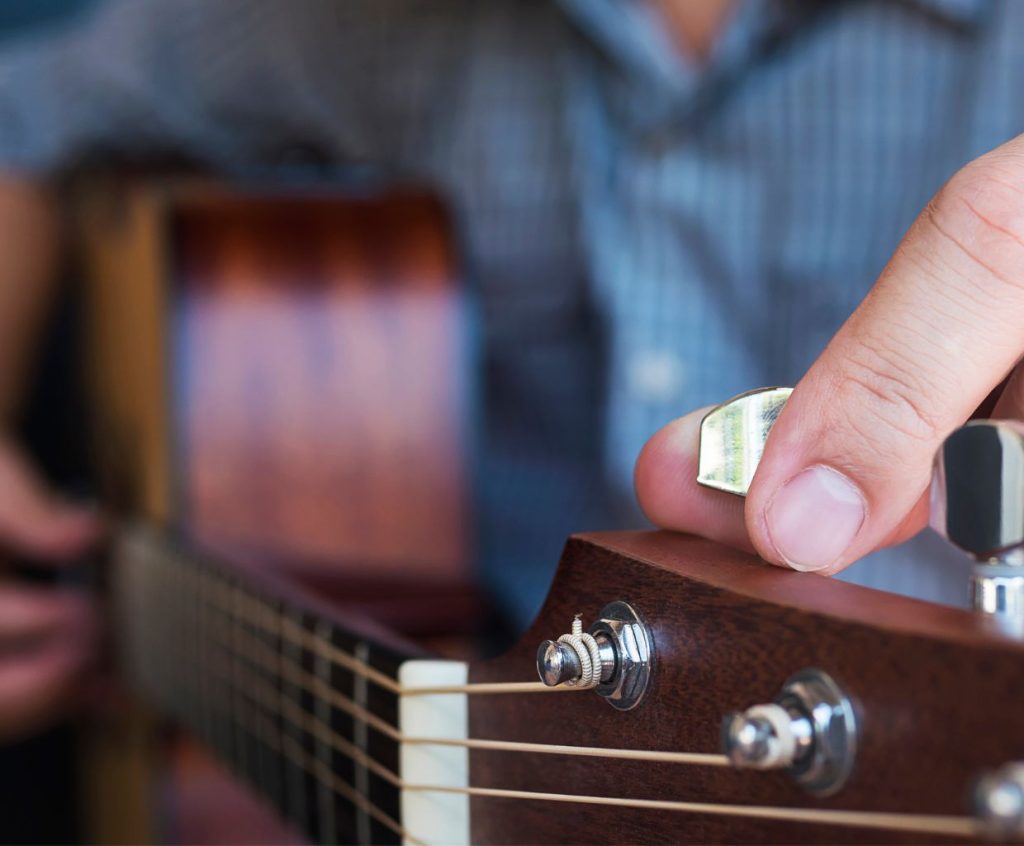How To Fine Tune A Guitar By Ear Without The Aid Of Instruments Or Devices
Playing out of tune is one of the worst things to happen to a guitarist. It doesn’t matter how qualified you are, how fast you can play, or accurate; if your acoustic or electric guitar is out of tune, it will sound bad anyway.
Two popular ways to tune the guitar are via a tuner and ear.
Table of Contents
- 1 How To Fine Tune A Guitar By Ear Without The Aid Of Instruments Or Devices
- 1.1 Fine Tune A Guitar By Ear – Introduction
- 1.2 Principal Benefits Of Knowing How To Fine Tune A Guitar By Ear Without External Aid
- 1.3 Other advantages of this method that I will present
- 1.4 Tune A Guitar By Ear – Knowing your loose strings.
- 1.5 Using The Intervals To Fine Tune A Guitar By Ear
- 1.6 Fine Tuning The Guitar Through The Vibration
Fine Tune A Guitar By Ear – Introduction
Naturally, fine-tuning via an electric guitar tuner or with software is the most accurate way and the best choice. However, there will inevitably be times when you will not have your electric finer tuner or software with you, and then what do you do? The key is always appealing to tuning by ear; it becomes an invaluable skill! Apart from that, this is an excellent way to demonstrate your level of interest as a musician.
Although it is not something you develop overnight, it also does not demand supernatural hearing when learning how to tune a guitar fine. All you need is to sharpen your hearing and understand the notes better. Ideally, the best way to fine-tune the guitar by ear is through another instrument tuned as a reference.
But as we know, it is only sometimes possible, and will be no point in knowing how to fine-tune by ear depending on another instrument nearby; for this reason, we will explore some technical ways of fine-tuning by ear using both methods. But for now, in this lesson, let’s focus only on the acceptable tuning method without a nearby instrument’s help.
Principal Benefits Of Knowing How To Fine Tune A Guitar By Ear Without External Aid
So, what is the advantage of fine-tuning the guitar by ear? First, learning to hear the intervals between the strings and notes will transfer this ability to other areas when learning to play the guitar. The more familiar you become with the sound relationship between two or more notes/strings, the less you will have to rely on other tools or external resources.
Secondly, this first method of fine-tuning that I will present, in my opinion, beats the standard method of the 5 cases because instead of tuning a pressed string (that causes natural inaccuracies), you will be tuning open strings, which will be a loose pitch string to another loose string. I use this method all the time because it turns out to be the fastest way to fine-tune once you master this method.
Other advantages of this method that I will present
Another characteristic I like more about this method, instead of the traditional one is that, in this case, the strings aren’t perfectly tuned to their standard (E A D B e). Still, they maintain relatively great tuning about the other strings. For example, the string E (thick) may be slightly below tuning MI (E), but it won’t be a problem if the other strings present the exact relation of tuning to its notes. This way, your chords will always sound good!
This lesson deals with pallet two strings and whether they are tuned about each other without any external help.
Note: This method will not work if you are playing with other perfectly tuned instruments; it only serves for those moments when you have nothing at hand except your guitar.
So let’s go!
Tune A Guitar By Ear – Knowing your loose strings.
Learning how to use this method requires that you already know the sound of the loose strings of your guitar and fine-tune your guitar well, whether it be your tuner or with this online acoustic and electric guitar tuner.
Okay, are you with your fine-tined guitar? Now play all the strings starting from the thickest to the thinnest.
It’s essential to know the sound of each string one by one. What many guitarists don’t realize is that if you divide and play each string, for example, the E string (thicker) and A one after another, it represents an interval of a specific note you just played.
A perfect fourth interval, to be specific. It is these intervals that you must fix in your head! Listen to the strings E and A again below and try to absorb the range of sound between each string…
Try to sing the notes if you want; it also helps memorization. Now do the same with the strings A and D – it is the exact perfect fourth interval (in fact, every fourth interval and fifth are perfect), in other words, the exact relation of strings E and A, but from a different note.
Now do the same process on the strings D and G – which is the same fourth range as the previous processes.
The intervals will differ when you get to the strings G and B. They are the third largest intervals. Try to memorize this range of sounds.
And now the last interval between the strings B and E (fine). It is the same as the fourth interval of the strings E – A, A – D, and D -G ( a little larger, obviously).
Learn these sound intervals before moving on to the next step.
Using The Intervals To Fine Tune A Guitar By Ear
I made you learn the sound of each pair of strings because you can use these intervals as a tuning tool with them. You’re using your ear as a guide here – the goal is to make the intervals harmonious. If they are not, it is because they are out of tune.
Examples:
Start with the strings E (thicker) and A. Do they sound ok?
Yep, it seems to be ok. Now A and D?
It’s also fine-tuned. And now D to G?
Oops! The G string has a very low tune, so we need to tune it. We know that the G string is out of tune because we previously established that the d string was tuned with A ( and the string A with E). This way, there are no mistakes!
Now that we know the g string is ok, we can proceed with G and B strings – remember that your enter ranges here are different.
Ok, it is not tuned! We need to lower its tune slightly.
Note: The B string is a little weird due to the nature of the guitar; with this string, you need to tune the B string slightly higher as if it were in the third largest natural. Listen to the following audio to feel what happens when we don’t tune it to a slightly higher frequency, and then play the chord MI major…
It sounds a little out of tune with the rest of the chords.
Even though the B string sounds perfectly tuned to the G string, some guitar chords will not provide a consonant form of sound. This is a personal observation from playing many guitars in which I felt this little problem. So all you need to do is to tune the B string slightly higher to compensate for it (please listen to me closely to hear me tuning).
So the tip is to tune in syntony with the G string and then tune again slightly higher. The B string, in particular, takes a while to get used to, but it will be less frequent.
And finally, we will verify if the B (thin) sounds well against the B string using the previous intervals we have already seen…
It seems all right!
Fine Tuning The Guitar Through The Vibration
You can try the method presented below if you still think it takes work to fine-tune the guitar by ear.
The best way to fine-tune by ear, from far away, is to play the chords in two groups, as we did previously. Still, this time we will have to pay closer attention to the “vibrational” details or oscillations between the fourth perfect pairs (Note: This doesn’t work with the chord Paris G – B because the fine-tuning intervals are different).
This vibratory effect tells you if this interval is perfect, and then you must lower or raise the tuning until this range is tuned and the vibration stops.
After using this method so many times repeatedly, your ear will automatically get used to these sensitive changes in tuning; that’s what we call a well-tuned ear.
Remember, some chords will sound good even if you are a little out of tune, while others will sound bad. So make “tuning your guitar with accuracy” a regular habit!



